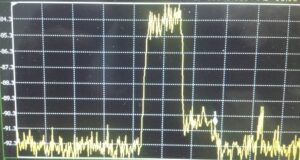CALL NOW (916)928-6000
Support | My Account | RMA | Blog
CALL NOW (916)928-6000
Support | My Account | RMA | Blog
 6 GHz microwave radio operators face an ominous challenge of protecting their networks ahead of Wi-Fi 6E deployments. Wi-Fi 6E is the latest 802.11ax standard allowing wireless devices to operate in the 5950 MHz to 7125 MHz bands. 5925 MHz to 7125 MHz has been the go-to long haul band critical infrastructure and service providers have used for decades to backhaul their networks. Wi-Fi 6E users are secondary operators and the FCC has implemented a variety of rules to keep interference “below detectable levels”. While great on paper, the true impact on existing 6 GHz microwave systems will not be known until after Wi-Fi 6E deployments. It is recommended that operators in the 5925 MHz to 7125 MHz bands ready themselves to detect and mitigate any interference.
6 GHz microwave radio operators face an ominous challenge of protecting their networks ahead of Wi-Fi 6E deployments. Wi-Fi 6E is the latest 802.11ax standard allowing wireless devices to operate in the 5950 MHz to 7125 MHz bands. 5925 MHz to 7125 MHz has been the go-to long haul band critical infrastructure and service providers have used for decades to backhaul their networks. Wi-Fi 6E users are secondary operators and the FCC has implemented a variety of rules to keep interference “below detectable levels”. While great on paper, the true impact on existing 6 GHz microwave systems will not be known until after Wi-Fi 6E deployments. It is recommended that operators in the 5925 MHz to 7125 MHz bands ready themselves to detect and mitigate any interference.
Baseline your system… A good baseline establishes expected network performance and enables quick troubleshooting of problems that may arise. Many methods can be used to baseline microwave radio systems such as bit error rate tests, spectrum analyzers, and monitoring programs. Using these tools on a routine basis will assist in detecting possible interference created by Wi-Fi 6E systems in your area.
Ensuring that your radio system is operating within FCC license specifications and up to date is crucial. Wi-Fi 6E systems use the FCC Universal Licensing System database to select operating frequencies so there is not interference to licensed systems. Incorrect information in the FCC database could lead to harmful interference. Existing licensed 6 GHz radio systems can also suffer from incorrect antennas, improper antennas heights, and incorrect polarities. These issues can go undetected for numerous reasons such as poor workmanship, lost institutional knowledge, and improper documentation. FCC license and hardware discrepancies can be very hard to troubleshoot in the field and can lead to interference by Wi-Fi 6E systems. Reviewing your FCC license data and physical installations are more important now than ever for proper system performance.
These ideas seem to be a daunting and time-consuming task, but necessary for the future health of your 6 GHz microwave system. FCC ULS has “noise” or errors in the database that I and others have found when doing license searches. We know the errors are there! The methods mentioned above will help you evaluate, detect, and protect your network. If you do end up experiencing any suspected interference or adverse network performance, you can look to Infiniti Wireless for help troubleshooting and resolving these issues. Additionally, we can offer network baseline measurements, training in doing baseline measurements, ULS scrubbing, and tutorials on how to detect interference caused degradation. We have engineers, technicians, and resources to assist with reviewing and advising on potential interference.
Please contact us today to learn more about Wi-Fi 6E and or interference mitigation.
Want to stay informed and up to date with the latest in the telecom industery?